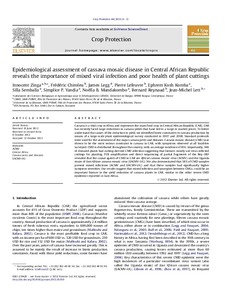| dc.contributor.author | Zinga, I. |
| dc.contributor.author | Chiroleu, F. |
| dc.contributor.author | Legg, J.P. |
| dc.contributor.author | Lefeuvre, P. |
| dc.contributor.author | Komba, E. |
| dc.contributor.author | Semballa, S. |
| dc.contributor.author | Yandia, S.P. |
| dc.contributor.author | Mandakombo, N. |
| dc.contributor.author | Reynaud, B. |
| dc.contributor.author | Lett, J. |
| dc.date.accessioned | 2019-12-04T11:03:25Z |
| dc.date.available | 2019-12-04T11:03:25Z |
| dc.date.issued | 2013 |
| dc.identifier.citation | Zinga, I., Chiroleu, F., Legg, J., Lefeuvre, P., Komba, E. K., Semballa, S., ... & Lett, J. M. (2013). Epidemiological assessment of cassava mosaic disease in Central African Republic reveals the importance of mixed viral infection and poor health of plant cuttings. Crop Protection, 44, 6-12. |
| dc.identifier.issn | 0261-2194 |
| dc.identifier.uri | https://hdl.handle.net/20.500.12478/1052 |
| dc.description.abstract | Cassava is a vital crop in Africa and represents the main food crop in Central African Republic (CAR). CAR has recently faced large reductions in cassava yields that have led to a surge in market prices. To better understand the causes of the reduction in yield, we identified biotic constraints to cassava production by means of a large-scale plant epidemiological survey conducted in 2007 and 2008. Standard protocols were used for the assessment of the major cassava pests and diseases. Cassava mosaic disease (CMD) was shown to be the most serious constraint to cassava in CAR, with symptoms observed at all localities surveyed. CMD is distributed throughout the country, with an average incidence of 85%. Importantly, 94% of diseased plants had cutting-derived CMD infection suggesting that farmers mostly use virus-infected cuttings for planting. PCR amplification and direct sequencing of partial fragments of the Rep ORF revealed that the causal agents of CMD in CAR are African cassava mosaic virus (ACMV) and the Uganda strain of East African cassava mosaic virus (EACMV-UG). We also demonstrated that 58% of CMD samples present mixed infections (ACMV and EACMV-UG) and that these samples had significantly higher symptom severities. Our results suggest that mixed infection and synergism between CMGs, could be an important feature in the yield reduction of cassava plants in CAR, similar to the other severe CMD epidemics reported in East Africa. |
| dc.language.iso | en |
| dc.subject | Cassava |
| dc.subject | Pests |
| dc.subject | Diseases |
| dc.title | Epidemiological assessment of cassava mosaic disease in Central African Republic reveals the importance of mixed viral infection and poor health of plant cuttings |
| dc.type | Journal Article |
| dc.description.version | Peer Review |
| cg.contributor.crp | Roots, Tubers and Bananas |
| cg.contributor.affiliation | Université de Bangui |
| cg.contributor.affiliation | Pôle de Protection des Plantes, France |
| cg.contributor.affiliation | Université de La Réunion |
| cg.contributor.affiliation | International Institute of Tropical Agriculture |
| cg.coverage.region | Africa |
| cg.coverage.region | East Africa |
| cg.coverage.region | Central Africa |
| cg.coverage.country | Uganda |
| cg.isijournal | ISI Journal |
| cg.authorship.types | CGIAR and advanced research institute |
| cg.iitasubject | Cassava |
| cg.journal | Crop Protection |
| cg.howpublished | Formally Published |
| cg.accessibilitystatus | Limited Access |
| local.dspaceid | 78050 |
| cg.identifier.doi | https://dx.doi.org/10.1016/j.cropro.2012.10.010 |

